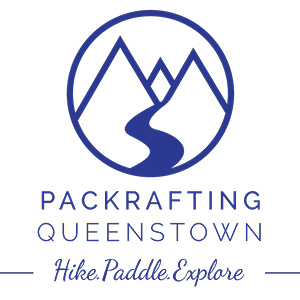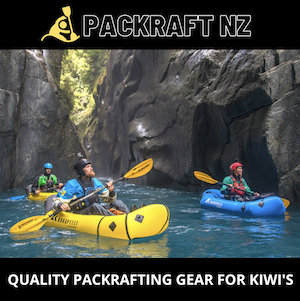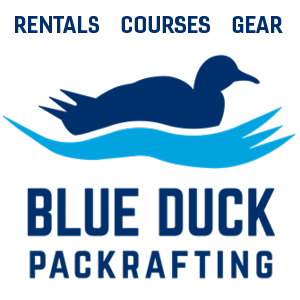This has always been regarded as the premier Tararua river for kayaking but it is dammed. On scheduled release days it was pretty popular and has some heavy Class IV features unsuitable for Packrafts. It was once a popular tubing river in low flows but residual flows are insufficient for it to receive much paddler use.
For most of the year it is virtually a dry riverbed. So its something to consider in late winter or spring. It has a tight gorge similar to the Hutt or Otaki and then a final gentler section which requires more water. So the challenge is to find a suitable weather window where it is not so low that the last 5-10 km becomes a chore.
Like all hydro rivers, it could be subject to spills at any time that drastically change the flow (and river grade). As of 2021 there are no programmed release dates because the spill diversion is programmed for repair. WWNZ are liaising with the operators on this.
Understand how it responds to flow before embarking on a trip!
View Larger Topographic Map
The Shuttle
It is a very long shuttle of over two hours and there is no walk in float out option. So it’s best to enrol a shuttle bunny.
To get to the put-in:
Turn off SH7 just north of Shannon and enjoy the lovely road as far as the Mangahao Slalom site. Now the road gets hellishly windy and narrow. Eventually, you will reach the massive concrete arch dam that stores water from the next catchment. Continue on around the lake and over into the next valley. At the bottom of the hill is the lower of two dams on the Mangahao. Twice a year by agreement King Country Energy allow a release for kayakers. It’s best to avoid these times as the crux rapids are not packraft friendly at these flows. Head down the track ten minutes to the river and inflate your packraft.
To get to the take-out:
Head north on SH7 and right over the Pahiatua Track. Once over the northern Tararua foothills, the road flattens. Near Makomako turn right turn to Marima. Once at Marima follow signs to Kopikopiko via Kopikopiko Road. This road turns to gravel a couple of kilometres out of Marima and stays this way to the bridge. The take-out is in a paddock on the river left just upstream of the bridge.
On the River
The natural flow of the river would be quite large (similar to the Otaki) and so the meagre residual flow occupies a wide bed. Enjoy the bush lined valley and chilled Class II boulder bank and pool paddling because after 4 kilometres it gets tight and very gnarly.
The gorge proper arrives with greywacke bedrock features there are a couple of rapids in the easy Class IV range. The gorge is jless than a kilometre long. The first rapid is a rocky chute that funnels flow down a chute with a vertical drop of a few metres to a tight gap in the bedrock. At low flow it is a dangerous undercut in the neck of the funnel and can be portaged river right. It’s unnamed but packrafters call it the “Funnel”.
A short distance on is “Dog-Leg” rapid (also referred to as the Crux rapid). There is a line straight through but the fun line is to take a dog leg path right then left before hitting a big hydraulic on the final drop. At low flows it is not runnable.
There follows a small drop and then a narrow section with multiple river wide logs. The gradient stays steep.
There are a few more bedrock drops. Scout and portage where necessary. At low flows, these rapids can still be hazardous and or boney.
As with all Tararua rivers, check in with someone who has run it recently and expect unexpected logs.

A Gnarly Drop at Low Flow (Max Grant)
Once clear of this tight gorge it’s a return to boulder gardens and there is a 4 kilometre long stretch of Class III water with fabulous scenery and boulder gardens. There are some decent drops over boulders in this section and as flow increases it will be harder to boat scout the long continuous rapids. A few of the rapids will be Class III+ or even IV- at higher flows. Notably Old Slip rapid past the big grassed slip and Slip rapid require a high standard of paddling. Progress will be slow with shore scouting for less capable paddlers.
Slip Rapid is a last megadose of excitement (125metres of full on bouldery goodness) before the river eases to CLass II at Ngapuketurua Stream.
At the confluence with the Ngapuketurua Stream the river changes direction to follow faulted rock along the Otaki Forks Fault. The bedload changes to finer gravels and the grade and gradient eases.
The confluence has the only decent camping site on the run. On river left 50m after the confluence and possibly amongst the trees on the flat behind the small grassed area.
The next Class II section(6.5km) is a little wider and needs water. The next gorge is red rocks gorge with volcanic rocks interspersed with the Greywacke. The river widens briefly and then swings east into another small gorge before reaching the farmland. Once farmland is encounter the river becomes braided and shallow Class I and II for 4.5km. The take-out is at the bridge (usually on river left). Kayakers can take 8 hours so consider overnighting at the put-in or after the gorge eases. Tubing trips are slow and need to be overnighters.
Gauge
The Gauge is Mangahao at Balance and shows the sorry state of the flow year round. Thanks clean green hydro!
The optimum flow band is a matter for ongoing resolution. Kayakers recommend 15 cumec or more.
6 cumec is a tubing flow – these trips involved floating pools and walking rapids. Packrafting at this flow took 10 hours and involved a lot of boat dragging. Best done on a long summer day with an empty boat.
Releases are 30 cumec and are meant to occur twice a year. King Country Electricity has been unable to fulfill the conditions of consent with respect to recreational and de silting releases which are meant to occur twice a year. Flow in releases are Class IV.
There are two dams on the river which harvest the flow of the river and divert it to a third dam and power station. The only flow that gets through the dam is leakage. There does not appear to be any minimum controlled release flow but the spill gates leak a few cumec.
Each dam has a spill gate of heart totara with a counterweight. As water builds up against the convex spill gate the weight eventually exceeds the counterweight. The gate trips and drains the top couple of metres off the lake. Hundreds of cumec are instantaneously released without warning. They release a massive pulse of water unannounced and then close till the flood water builds up again. This can result in sudden increases in flow which would not be desirable if you are in the main gorge.
This configuration means there are two options for paddling. The first is to paddle during rainfall when the dam level is low enough that there is no risk of the spill gates tipping. There are not a lot of side streams for some distance so the flow won’t pick up much. under this scenario.
The second option is to wait for a rainfall event to trip the flood gate and then wait for flow to reduce sufficiently to safely proceed. There is a flow phone 06 362 7588 that will give the lake level and whether the spill gates are open.
Based on the available information a day trip at 10 cumec would be a good starting point for a trip.
The wider downstream reaches will be pretty shallow at these flows. Help find the sweet spot by commenting if you do the trip.
Theres is limited video available but these show the Crux rapids on release days.






